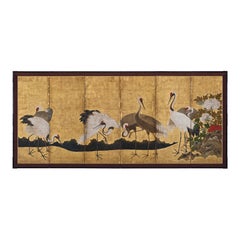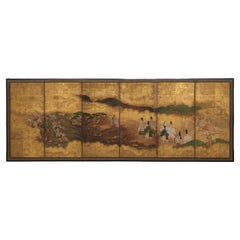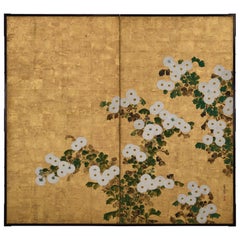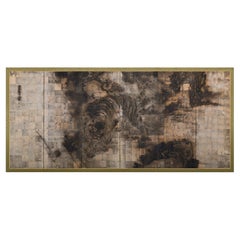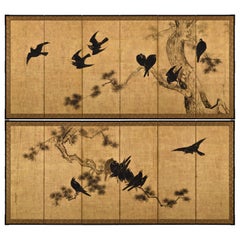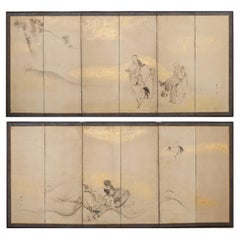18th Century and Earlier Paintings and Screens
to
8
87
30
172
1
1
172
682
911
150
314
195
107
38
4
33
14
12
25
29
28
26
8
119
74
70
66
61
164
154
122
29
5
172
172
172
2
1
1
1
1
Period: 18th Century and Earlier
17th Century Japanese Screen. Cranes and Peonies. Edo period.
Located in Kyoto, JP
Cranes and Peonies
Anonymous, Kano School.
Edo period, second half of the 17th century.
Six-panel Japanese screen. Ink, pigment gofun and gold leaf on paper.
This Japanese screen...
Category
Japanese Edo Antique 18th Century and Earlier Paintings and Screens
Materials
Gold Leaf
Mid-size 6-panel byôbu 屏風 with a scene from The Tale of Genji
Located in Amsterdam, NL
A refined medium-sized six-panel byôbu (folding screen) showcasing a classical autumn court scene from chapter 7 of The Tale of Genji (Genji Monogatari), titled Momiji no Ga (The Aut...
Category
Japanese Antique 18th Century and Earlier Paintings and Screens
Materials
Metal, Gold Leaf
18th Century Japanese Rinpa Screen. White Chrysanthemums. School of Korin.
Located in Kyoto, JP
School of Ogata Korin
White Chrysanthemums
18th Century, Edo period.
A two-panel Japanese screen. Ink, color, gofun and gold leaf on paper.
Dimensions: H. 171 cm x W. 188 cm (67.5” x 74”)
On this two-panel Japanese screen we see blooming chrysanthemums, a flower which embodies the essence of autumn in Japan. Here the traditional floral theme has been simplified and stylized. The bright colors and asymmetrical composition against the delicate gold leaf create a luxurious and ornate work of art. Its background, a strikingly patinated grid of gold leaf, denies any sense of place or time and imbues everything with an ethereal glow. The leaves and stems of the plants are nothing more than pools of mottled color and ink without any outline whatsoever. These are typical Rinpa adaptations of traditional ink painting methods; tarashikomi, or diluted washes of color blended while very wet, and mokkotsu, or “bonelessness,” which creates forms without exterior outlines. The relief work of the rounded flower petals has been obtained by the moriage process (a mixture based on ground shells modeled on the surface of the paper).
On the lower right of the screen, the siganture “Hokyo Korin Jakumyo” and the “Hoshuku” seal can be read. Korin is Ogata Korin, famed for the Irises (Nezu Museum) and Red and White Plum Blossom (MOA Museum of Art) folding screens, both National Treasures. Korin worked in both Kyoto and Edo in the mid-Edo period. Korin was using the art name “Jakumyo” just after he received the Hokyo level, which was in 1701.
This particular screen was published in May of 1961 in the Japanese Sansai Fine Art Magazine*. An in depth article accompanies the photograph of the screen and and a photograph of the signature and seal. This article devotes much of its body to discussing the moriage technique, how it enlivens the chrysanthemum flowers and Korin’s specific skill in using the technique. The article goes on to discuss the most famous works of Korin, utilizing this technique, which were known at the time. Specifically a two-panel screen held in the Honolulu Museum which was discovered in the store-house of Takahashi Soan. A two-panel screen pair which the Nakano family own. A two-panel screen pair with chrysanthemums in moriage in fan designs owned by the Nomura family. Also a small folding screen featuring chrysanthemums held in the Yamato Bunkakan. The article goes on to say that this particular two-fold screen came from the Nijo family. Korin is known to have had a strong connection with the aristocratic Nijo family. The article explains that Korin received a lot of favors from the Nijo family and that this screen would have been gifted to them.
Since that time the Honolulu screen has been amended to ‘attributed to Ogata Korin’ and I do not know further details of the other 3 screens. Other Chrysanthemum screens...
Category
Japanese Edo Antique 18th Century and Earlier Paintings and Screens
Materials
Gold Leaf
Edo period Japanese Screen. Tiger and Pine by Kishi Ganku.
Located in Kyoto, JP
Kishi Ganku (1749/1756-1838)
Tiger and Pine
A six-panel Japanese Screen. Ink on silver leaf.
The central focus of this Japanese screen is a large tiger, emerging from shadow, crou...
Category
Japanese Edo Antique 18th Century and Earlier Paintings and Screens
Materials
Silver Leaf
Mid 18th Century Japanese Screen Pair. Crows & Pines by Unkoku Toshuku.
Located in Kyoto, JP
Unkoku Toshuku (1722-1779)
Crows and Pines
A pair of six-panel Japanese Screens. Ink and gold leaf on paper.
Dimensions: Each Screen: H. 170.5 cm x W. 375 cm
Haha-cho or mynah birds, whose forms resemble crows in artwork, were commonly depicted in Japanese art. These types of paintings were originally modeled on paintings attributed to the 13th century Chinese painter Muqi (Mokkei), whose art was enormously influential in Japan. Crows only became a theme among Japanese artists from the later 1500s onward. They likely were inspired by these imported Chinese paintings of myna birds, which are not native to Japan, substituting the native species of crow instead.
The best known early examples of the depiction of Japanese crows are two Momoyama screen...
Category
Japanese Edo Antique 18th Century and Earlier Paintings and Screens
Materials
Gold Leaf
Pair of 18th Century Japanese Edo Screens of Chinese Immortals
Located in Rio Vista, CA
Mesmerizing pair of late 18th/early 19th century Japanese Edo period byobu screens by Shibata Gito (Japanese 1780-1819). The paintings depict Chinese immortals in a dreamy landscape....
Category
Japanese Edo Antique 18th Century and Earlier Paintings and Screens
Materials
Silk, Wood, Paper
Japanese Edo Two Panel Screen Meandering Stream with Birds
Located in Rio Vista, CA
Weathered Japanese late 18th century Edo period two-panel byobu screen depicting a meandering stream with sparrows in flight. Crafted with natural ink and color pigments on mulberry ...
Category
Japanese Edo Antique 18th Century and Earlier Paintings and Screens
Materials
Brass
17th Century Japanese Screen. View of West Lake by Unkoku Toyo.
Located in Kyoto, JP
Unkoku Toyo (1612-1668)
View of West Lake
Pair of eight-panel Japanese Screens. Ink and gold wash on paper.
Dimensions: Each screen: H. 110 cm x W. 372 cm (43” x 147”)
This pair ...
Category
Japanese Edo Antique 18th Century and Earlier Paintings and Screens
Materials
Paper
Circa 1700 Japanese Screen Pair, Cranes & Pines, Kyoto Kano School
Located in Kyoto, JP
Pines and Cranes
Anonymous. Kyoto Kano School.
Late 17th/early 18th centuries, circa 1700.
Pair of six-panel Japanese folding screens.
Ink, gofun, pigment and gold leaf on paper.
This bold composition presents two pine trees extending to the left and right across a gold leaf background. One tree is silhouetted against a green ground, golden clouds obscuring its true size, the other stretches across a stylized waterway. The pines are paired with Manchurian cranes with red crests and snow white plumage. Both have been highly auspicious motifs in East Asia since Chinese antiquity. Here the artist utilized fluid and instinctive ink brushstrokes to define the trunk, branches and tail feathers, in strong contrast to the precision and sharp angularity of the crane’s legs and beaks. The adoption of this vast metallic painting support required an unerring sense of design and composition, so that the negative space surrounding motifs could imply context for the otherwise floating pictorial elements. The brushwork detailing the trunks of the pines, the exaggerated dimensions of the pine trees and the strength and dynamism of the composition are all reminiscent of Kano Eitoku...
Category
Japanese Edo Antique 18th Century and Earlier Paintings and Screens
Materials
Gold Leaf
Antique 18th Century Pair Indian Hindu Erotic Kamasutra Miniature Paintings 1750
Located in Portland, OR
A fine quality pair of antique 18th century Indian erotic Kamasutra paintings, circa 1750.
The paintings most likely North-East India or possibly Nepal, are very finely painted with ...
Category
Indian Anglo-Indian Antique 18th Century and Earlier Paintings and Screens
Materials
Paint
Pair of 18th Century Coromandel Panels with Chinese Chippendale Frames
Located in Bradenton, FL
Pair of 18th century Coromandel panels with Chinese Chippendale Frames. with a scene depicting figures with pavilions and having Chinese Chippendale ebonized fretwork carved frames.
Category
Chinese Chinese Chippendale Antique 18th Century and Earlier Paintings and Screens
Materials
Lacquer
18th Century Tibetan Thangka Painting
Located in Chicago, IL
A rare striking 18th century Tibetan Thangka depicting the Green Tara seated on a lotus throne ready to step down to offer comfort and pro...
Category
Tibetan Tibetan Antique 18th Century and Earlier Paintings and Screens
Materials
Linen, Paint
$18,750 Sale Price
25% Off
Japanese Chinese Asian Large Six-Panel Folding Byobu Screen Mythical Landscape
Located in Studio City, CA
A gorgeous, strangely beautiful, unusually engaging, and alluring hand-painted large six-panel Japanese/Asian Byobu folding screen depicting an almost magical/ mythical nature scene ...
Category
Japanese Edo Antique 18th Century and Earlier Paintings and Screens
Materials
Gold Leaf
Pair of Japanese kakejiku 掛け軸 (hanging scrolls) depicting Niô guardians 仁王
Located in Amsterdam, NL
Pair of impressive, antique kakejiku (hanging scrolls) showcasing the awe-inspiring Niô guardians, also referred to as heavenly kings.
Each painting cap...
Category
Japanese Antique 18th Century and Earlier Paintings and Screens
Materials
Brocade, Silk, Paint
Mid-18th Century Japanese Screen Pair, One Hundred Flowers, Chrysanthemums
Located in Kyoto, JP
Omori Soun (b. 1704)
Chrysanthemums - One Hundred Flowers
A Pair of Six-fold Japanese Screens. Ink, color, gofun and gold leaf on paper.
Dating ...
Category
Japanese Edo Antique 18th Century and Earlier Paintings and Screens
Materials
Gold Leaf
Japanese antique screen - EDO period - Willow over a stream
Located in Prahran, Victoria
Antique Japanese 6 panel screen from the early Edo period (C1650). One of a pair (both available). This magnificent golden screen shows...
Category
Japanese Edo Antique 18th Century and Earlier Paintings and Screens
Materials
Gold Leaf
17th Century Japanese Screen Pair. Tiger & Dragon by Kaiho Yusetsu
Located in Kyoto, JP
Kaiho Yusetsu (1598-1677)
Tiger and Dragon
Early Edo Period, Circa 1650
A Pair of Six-fold Japanese Screens. Ink and slight color on paper.
Dimensions:
Each screen: H. 171 cm x W. 380 cm (67.5’’ x 149.5’’)
In this pair of early Edo period Japanese screens a group of tigers prowl in a bamboo grove whipped with fierce wind, while a dragon claws through clouds and mist. The dragon embodies elemental qualities - looming out of the mist, the coils of its body disappearing in the clouds. The dragon is calling for rain, symbolizing spring which is considered the fountain of life. On the other side, the tigers calls for the wind, symbolizing autumn which is considered the end of life. Tigers were familiar motifs within Japanese art from ancient times though the animals were imaginary to the people in the 17th century. While dragons and tigers are usually associated as sacred and ferocious, in this painting, both animals have rather amusing expressions. The tigers appear to glare at the dragon with cat-like eyes, and the look on the swirling dragon’s face appears almost affectionate - lending a playful flair to an otherwise magnificent theme.
The tiger and dragon are cosmological symbols of the balancing forces in the world. Screens such as this were originally meant to express the fluctuating nature of the world. For Japanese in the early Edo period, they likely suggested the powers of the cosmos. In Japan the tiger and dragon motif was originally absorbed into the circles of Zen monasteries before spreading into the secular world. The theme especially appealed to the military classes with the Kano school, the official painters to the Shogun and the samurai, being the leading contributors. The painter of this pair of screens, Kaiho Yusetsu (1598-1677), was closely patronized by the third Shogun Tokugawa Iemitsu. In his later years he worked with Kano school artists...
Category
Japanese Edo Antique 18th Century and Earlier Paintings and Screens
Materials
Silk, Wood, Paper
Byobu - Japanese Screen "Kano School" Gold Leaf
Located in Brescia, IT
Japanese Kano School Six Panel Screen: Landscape with Beautiful and Elegant Cranes near the River, with Pines and Sakura.
Hand painted with mineral pigments and inks on vegetable pap...
Category
Japanese Edo Antique 18th Century and Earlier Paintings and Screens
Materials
Gold Leaf
Set of 6 Antique Chinese Lattice Panels
Located in Kastrup, DK
Set of six wood carved Chinese 17-18th century Qing dynasty panels or room divider.
Each panel features an main section with an open fretwork design lattice panel window, comprised by a pattern of a connecting cherry blossoms. Relief foliate lattice design on the top and bottom of the window.
The bottom panels are designed with solid wood panels adorned with a hand painted flower motif at the bottom.
Panels such as these were used to easily divid- or open up a room. These Qing panels...
Category
Chinese Qing Antique 18th Century and Earlier Paintings and Screens
Materials
Wood
$6,868 / set
17th Century Japanese Screen Pair. Flock of Cranes. Ink and color on gold leaf.
Located in Kyoto, JP
A pair of six-fold Japanese screens from the 17th century depicting a flock of cranes arriving at their wintering grounds. The expansive scene is heavily atmospheric. The cranes are...
Category
Japanese Edo Antique 18th Century and Earlier Paintings and Screens
Materials
Gold Leaf
18th Century Japanese Floral Paintings, Set of 5, Mineral Pigments on Gold Leaf
Located in Kyoto, JP
A set of 5 Japanese floral paintings from the 18th century. Each painted with mineral pigments directly applied to gold leaf. They were originally designed to be mounted on the leave...
Category
Japanese Edo Antique 18th Century and Earlier Paintings and Screens
Materials
Gold Leaf
Late 17th Century Japanese Screen Pair. Battle of Ichi-no-tani and Yashima.
Located in Kyoto, JP
Anonymous
Late 17th Century
Battle of Ichi-no-tani & Yashima
Dimensions: Each Screen: H. 175 cm x W. 385 cm (69” x 151.5”)
This pair of Japanese screens depict two significant battles from the Genpei War (1180–85), as recounted in the Tale of the Heike, a semi-historical epic chronicling the conflict between rival clans for control of Japan, written in the early 1200s.
Each screen portrays a single battle through a series of small episodes, framed by gold clouds, landscape elements, and architectural features. True to the style of many screens inspired by The Tale of the Heike, the scenes are rendered in lavish colors and gold, downplaying the brutality of the warfare. Although based on real events, these narratives often glorified and romanticized the heroic feats of the warriors. Viewers at the time would have been familiar with the story’s details, leading to a proliferation of paintings on folding screens inspired by this theme from the late Muromachi to the early Edo periods.
On the right screen, we see the Minamoto’s attack on the Taira, who have retreated from the capital, Kyoto, toward the sea. The central building represents the temporary Taira headquarters, where Taira soldiers are holding the young Emperor Antoku. The Minamoto plan to launch a surprise attack from the rear after descending the steep cliff known as Ichi-no-tani, depicted at the top center. This scene highlights the tactical brilliance of Minamoto commander Yoshitsune and the courage of his men.
The left screen captures moments from the Battle of Yashima...
Category
Japanese Edo Antique 18th Century and Earlier Paintings and Screens
Materials
Gold Leaf
Pair of Indian Erotic Paintings from a Kama Sutra Series
Located in Dallas, TX
Presenting a stunning piece of Indian antiquity from the 17th century, namely, a pair of indian erotic paintings from a kama sutra series.
India, Orissa, 17th century.
Hand-painted on cloth canvas.
These have impeccable Provenance!
They were purchased by a Private Dallas Collector at Christie’s New York Auction on 19th September 2002. Sale Number 1115, Lot No. 251.
Christie’s operate a twice yearly auction of Southeast Asian Art & Antiquities in New York in the months of March and September.
The Lot was described as: “Two Erotic Paintings from a Karma Sutra...
Category
Indian Archaistic Antique 18th Century and Earlier Paintings and Screens
Materials
Canvas
Japanese Screen Painting, Circa 1700 'Tales of Ise' by Tosa Mitsusuke
By Tosa Mitsusuke 1
Located in Kyoto, JP
A six-fold Japanese screen by Tosa Mitsusuke (1675-1710), Japan 17th-18th century, Edo period.
The signature reads Shoroku-i ge Tosa sa Konoe Shogen Mit...
Category
Japanese Edo Antique 18th Century and Earlier Paintings and Screens
Materials
Gold Leaf
17th Century Japanese Edo Four Panel Screen Hotei with Chinese Sages
Located in Rio Vista, CA
Beautifully weathered late 17th/early 18th century Japanese edo period four panel byobu screen depicting hotei (fat monk) in a treed landscape with Chinese sages engaged in leisurely...
Category
Japanese Edo Antique 18th Century and Earlier Paintings and Screens
Materials
Brass
Japanese Asian Pair of Large Six-Panel Folding Byobu Screens Mythical Landscape
Located in Studio City, CA
A beautiful, alluring, wonderfully composed and engaging hand-painted large pair of six-panel Japanese/Asian Byobu folding screens depicting an almost magical/ mythical village scene...
Category
Japanese Meiji Antique 18th Century and Earlier Paintings and Screens
Materials
Gold Leaf
China Trade Painting on Paper depicting Feeding of Silkworms
Located in Downingtown, PA
China Trade Painting on Paper,
Silk Processing-Feeding of Silkworms,
Circa 1780-1820
A fine China Trade watercolor and gouache on paper depicting two of the steps in the processing ...
Category
Chinese Chinese Export Antique 18th Century and Earlier Paintings and Screens
Materials
Paper
Chinese Ming Dynasty Carved Table Screen
Located in Kastrup, DK
A rare 16-17th cenury Ming Dynasty standing table screen. Untoched original condition.
Hand carved wood, the panel is carved with relief details depicting a dragon, cranes, mythical...
Category
Chinese Ming Antique 18th Century and Earlier Paintings and Screens
Materials
Wood
Japanese Screen mid Edo gold leaf
Located in Brescia, IT
This 18th century six-panel screen is truly special. The author is unknown, but his singular genius in portraying dozens of chrysanthemum flowers created with the white of the "gofun...
Category
Japanese Edo Antique 18th Century and Earlier Paintings and Screens
Materials
Gold Leaf
Edo Landscape Japanese Folding Screen
Located in Brescia, IT
Refined work by a painter from the first half of the 19th century, from the landscape of the "Rinpa" school by a painter from the end of the 18th century, the Rinpa school.
Six panels painted in ink on gold leaf and "gofun" on vegetable paper.
The flowers are made with the "gofun" technique, natural or pigmented white oyster powder.
Rinpa is one of the major historical schools of Japanese painting. The style was consolidated by the brothers Ogata Korin (1658–1716) and Ogata Kenzan (1663–1743).
This folding screen has a very clean design that leaves plenty of room for the beautiful golden landscape.
It comes flat and you can easily hang it with our hooks.
Lucio Morini...
Category
Japanese Edo Antique 18th Century and Earlier Paintings and Screens
Materials
Gold Leaf
Antique Japanese Six-Panel Screen by Kano Chikanobu "Shushin"
Located in Prahran, Victoria
Late 17th century Kano school peony landscape screens. Both screens signed: Hogan Josen Fujiwara Chikanobu Hitsu - Kano Chikanobu (Shushin) (1660 - 1728...
Category
Japanese Edo Antique 18th Century and Earlier Paintings and Screens
Materials
Gold Leaf
18th Century Japanese Screen Pair. Plum & Young Pines. Kano School.
Located in Kyoto, JP
Dimensions (Each screen): H. 176 cm x W. 378 cm (69’’ x 149’’)
This pair of Japanese folding screens depict blossoming plum trees amongst young pines. They are designed to capture t...
Category
Japanese Edo Antique 18th Century and Earlier Paintings and Screens
Materials
Gold Leaf
Persian Manuscript Page - Garden Scene
Located in Soquel, CA
Persian Manuscript Page depicting a garden scene. Circa 18th century.
Hand painted scene depicts a hilly outdoor landscape where people are congre...
Category
Persian Islamic Antique 18th Century and Earlier Paintings and Screens
Materials
Gold Leaf
$390 Sale Price / item
35% Off
Edo Period Kyoto Screen
Located in Fukuoka, JP
Edo Period Kyoto Screen
Period: Edo period
Size: 343 x 176 cm (134.6 x 69 inches)
SKU: RJ69
This stunning Edo period screen depicts typical scenes of d...
Category
Japanese Edo Antique 18th Century and Earlier Paintings and Screens
Materials
Silk, Wood, Paper
$9,450
Chinese Export Watercolor Exotic Bird Paintings on Paper
Located in Downingtown, PA
China Trade watercolor paintings of exotic birds on branches are in watercolor and gouache on Chinese paper.
One picture depicts a pigeon perched on a tree branch with a landscape background. Chinese calligraphy can be seen in the top right corner. The second picture depicts two courting birds in shades of brown, both perched on a branch, also in a landscape background.
Both paintings framed with a green silk mat and contemporary gilt and dark wood frame.
Reference: Chinese Export...
Category
Chinese Chinese Export Antique 18th Century and Earlier Paintings and Screens
Materials
Paper
Circa 1700 Japanese Sliding Door (Fusuma) Set. Pine Trees on the Seashore.
Located in Kyoto, JP
"Pine Trees on the Seashore"
A set of four sliding doors (Japanese fusuma). Ink, color, gold-leaf and gold-fleck on paper.
Dimensions (total display si...
Category
Japanese Edo Antique 18th Century and Earlier Paintings and Screens
Materials
Gold Leaf
Japanese Six Panel Paper Screen
Located in Essex, MA
Six panel Tosa school with rich colors depicting a river and bridge. Featuring people in various pursuits. Descended in the Thayer family of Massachusetts.
Category
Japanese Antique 18th Century and Earlier Paintings and Screens
Materials
Paper
Evolving Elegance: An Oxidized Silver Screen from the Meiji Period
Located in Fukuoka, JP
This anodized 6-panel screen captures the serene and minimalistic beauty of a bamboo grove, embodying the aesthetic principles of the Edo period. The screen features subtle and delic...
Category
Japanese Edo Antique 18th Century and Earlier Paintings and Screens
Materials
Silver Leaf
17th Century Japanese Screen Pair by Soga Nichokuan, Hawks on Pine & Plum Trees
Located in Kyoto, JP
Hawks on plum and pine
Soga Nichokuan (active circa 1625-1660)
Pair of six-fold screens.
Ink, mineral pigments, gofun, gold and speckled gold l...
Category
Japanese Edo Antique 18th Century and Earlier Paintings and Screens
Materials
Wood, Paper
18th Century Five-Panel Chinese Coromandel Screel
Located in CABA, AR
Transport yourself back to the opulent splendor of the 18th century with this magnificent Chinese five-panel black Coromandel screen, a true m...
Category
Chinese Chinese Export Antique 18th Century and Earlier Paintings and Screens
Materials
Gold Leaf
$10,500 Sale Price
30% Off
18th Century Chinese Heavily Detailed 8-Panel Coromandel Screen
Located in New Orleans, LA
18th century Chinese heavily detailed 8-panel Coromandel screen, decorated on either side, with carved open work at top and bottom of each panel, heavily gold-leafed. On the front ar...
Category
Chinese Antique 18th Century and Earlier Paintings and Screens
Materials
Giltwood
Chinese Six-Panel Decorative Folding Screen, Circa 1780
Located in Charleston, SC
Chinese six-panel folding screen with decorative carved forest with standing and flying cranes, with reverse side depicting village and figures of people, terminating on brass square...
Category
Chinese Chinese Export Antique 18th Century and Earlier Paintings and Screens
Japanese Screen Pair, circa 1730, Peacocks and Phoenix, Kano School
Located in Kyoto, JP
Phoenix and Peacocks.
A pair of six-panel Japanese folding screens by Tsunetake Yotei (n.d.)
First half of the 18th century.
The signature reads 67 year old Tsunetake.
The seals read:
-Tsunetake no in,
-Yotei,
-Seishin
Dimensions:
Each screen – H. 69” x W. 149” (176 cm x 378 cm)
A pair of Kano Grand Picture (Waga) screens depicting phoenix and peacocks rich with symbolic meaning. Dating to the first half of the 18th century, from the Kobikicho Kano school in Edo, this pair of folding...
Category
Asian Edo Antique 18th Century and Earlier Paintings and Screens
Materials
Gold Leaf
Japanese Screen Painting, circa 1700 'Horses' by Kano Tanshin
Located in Kyoto, JP
Horses
Kano Tanshin Morimasa (1653-1718)
Two-panel tea-ceremony Japanese screen or furosaki
Ink on gold leaf,
late 17th-early 18th century
Measures: H 55 cm x W 182 cm
The Kano school was closely aligned with the warrior class in Japan. The samurai, who lived in a closed and rigid hierarchical society established by the Shogunate, were drawn to the energy and freedom horses symbolize; Kano school artists commonly depicted the equine creatures as they are here, in unfettered and carefree family groups. China originally introduced horse paintings to Japan; the works typically focused on capturing the essence of horses in their various environments and often involved integrating human figures into the images.
Kano Tanshin Morimasa (1653-1718) was the son of Kano Tanyu...
Category
Japanese Edo Antique 18th Century and Earlier Paintings and Screens
Materials
Gold Leaf
Antique Japanese Suibokuga Landscape by Kano Tokinobu, 17th century.
Located in Point Richmond, CA
Antique Japanese Suibokuga Landscape by Kano Tokinobu, 17th century. A sumi-e ink on paper painting illustrating a rocky seaside landscape containing buildings, vegetation and ship masts. The painting with 3 vermillion seals of the artist in the lower left corner. Japanese dry mount paper on a wood frame with thin brocade border silver leafed surround and lacquered wood outer frame.
Condition: Lighter discoloration near the bottom of the painting, various paper restorations, other minor signs of age, wear, stains, otherwise fine condition.
Age: Painting Edo Period, circa 1670. Mounting circa 1985.
Image: 51-1/2 in. x 20-1/2 in. (131cm x 52cm)
Frame: 59-1/4 in. x 25-1/4 in. (150cm x 64cm)
Weight: 6 lbs.
Provenance:
with Honeychurch Antiques...
Category
Japanese Edo Antique 18th Century and Earlier Paintings and Screens
Materials
Paper
17th Century Korean Grapevine and Squirrel Scroll Painting, Mid Joseon Period
Located in Kyoto, JP
Anonymous. Korean, 17th century. Joseon period.
Hanging scroll. Ink on paper.
Seal: Shinso
Dimensions:
Scroll: H. 200 cm x W. 31 cm (79” x 12”)
Image: H. 122 cm x W. 29.5 cm (48” x 11.5”)
The grapevine came to China and then Korea from western Asia via the silk road trade routes. By the mid-Joseon period, it was one of the most popular subjects for Korean literati painters. Grapevines were painted as a singular subject or, less commonly, in combination with squirrels, which are associated with children due to their playful nature. Together, grapevines and squirrels embody wishes for abundant offspring and wealth.
For the Korean literati artist the twisting vines, curling tendrils and round, plump grapes provided ample opportunity for expressive "brush play”. In this painting the artist has abstracted the scene and is seemingly unconcerned with discontinuities and proportion. Vines spring up from nowhere, grapes hang in random clusters and the squirrel’s head appears as if twisted backwards. For the vines and leaves we can feel a sense of speed in the brushstrokes, imparting a dynamic feel which is at once intense and animated. This contrasts dramatically with the countless tiny strokes of ink which realistically capture the texture of the squirrel’s fur...
Category
Korean Other Antique 18th Century and Earlier Paintings and Screens
Materials
Paper
The Plovers over the Sea Shores Screen
Located in Fukuoka, JP
The Plovers over the Sea Shores Screen
Period: 18th century (Edo period)
Size: 360 x 170 cm (141.7 x 66.9 inches)
SKU: PA39
Travel back in time with this classic Edo period screen,...
Category
Japanese Edo Antique 18th Century and Earlier Paintings and Screens
Materials
Wood, Paper
18th Century French or Italian Hand-Painted Chinoiserie Panel
Located in Bradenton, FL
Elegant 18th / 19th century hand-painted French or Italian Chinoiserie panel. Panel features colorful branches filled with exotic birds, flowers, butterflies, and Asian characters an...
Category
French Chinoiserie Antique 18th Century and Earlier Paintings and Screens
Materials
Silk, Giltwood
Japanese Painting, 17th Century, Tale of Genji, Tosa School
Located in Kyoto, JP
Illustration to an unidentified chapter of the Tale of Genji (Genji Monogatari)
Tosa School (second half of the 17th Century)
Ink, pigment, gofun and...
Category
Japanese Edo Antique 18th Century and Earlier Paintings and Screens
Materials
Gold Leaf
17th Century Japanese Screen. Karako Asobi: Chinese Children at Play.
Located in Kyoto, JP
Anonymous Kano school artist
17th century
"Karako Asobi: Chinese Children at Play"
A two-panel Japanese Furosaki screen. Ink, pigment, gofun and gold-leaf on paper.
This small Japanese Karako folding screen vividly depicts various games played by children wearing wearing elaborate Chinese T'ang dynasty costumes. They are dressed in plumed and tasseled hats, ornate jackets, baggy pants, and cloth slippers typical of T'ang period Chinese court dress. The children are depicted pulling a younger child along in a cart, carrying another child as if an important official, riding a wooden horse, leading a puppy and carrying a tethered bird. Executed in fine-quality pigments on gold leaf, the detail, variety and size of the figures is noteworthy. Also notable is the size of this screen itself, which denotes it as a Furosaki screen. A Furosaki screen is part of the equipment used for the Japanese tea-ceremony. It is traditionally placed on tatami mats behind the brazier highlighting the utensils and providing a focal point.
Karako is a Japanese term used in art with the depiction of Chinese children playing...
Category
Edo Antique 18th Century and Earlier Paintings and Screens
Materials
Gold Leaf
Early Edo Period Chinese-Inspired Screen
Located in Fukuoka, JP
This remarkable screen from the early Edo period, circa the 17th century, showcases the influence of early Chinese art forms with its intricate ink work on a gold leafed surface. The...
Category
Japanese Edo Antique 18th Century and Earlier Paintings and Screens
Materials
Gold Leaf
The Plovers over the Sea Shores Screen (2/2)
Located in Fukuoka, JP
The Plovers over the Sea Shores Screen
Period: 18th century (Edo period)
Size: 360 x 170 cm (141.7 x 66.9 inches)
SKU: PA39
Travel back in time with this classic Edo period screen,...
Category
Japanese Edo Antique 18th Century and Earlier Paintings and Screens
Materials
Wood, Paper
A Chinese mid 18th century Laquered Coromandel screen
Located in West Palm Beach, FL
A monumentally scaled and most important Chinese mid 18th century Laquered Coromandel screen. This finely detailed ten panel screen, with its original tempera paint, showcases a collection of continuous scenes depicting a landscape with pagodas, pavilions, a court of noblemen, women, and musicians. Each panel displays tones of rose, green, cafe brown, and gold on a dark rose ground within a border of wandering mischievous dragons and Greek key designs. The rear is tastefully decorated in the center with Chinese calligraphy relating to the story of the front with a border of flowers in vases, animals, and various figures.
This wonderful screen was formerly in the Collections of Viscount Furness and Lady Musker, as well as being sold by Mallet Antiques...
Category
Chinese Antique 18th Century and Earlier Paintings and Screens
Materials
Wood, Lacquer
Late 17th Century Japanese Screen. Puppy and Kittens on Gold Leaf.
Located in Kyoto, JP
Anonymous
Late 17th century
Puppy & Kittens
A six-panel Japanese screen. Ink, color, gofun, gold-leaf and gold-fleck on paper.
A medium sized late 17th century Japanese screen fe...
Category
Japanese Edo Antique 18th Century and Earlier Paintings and Screens
Materials
Gold Leaf
Lovely 17th-18th Century Scroll Painting Japan Artist Kano Soyu Painted
Located in Amsterdam, Noord Holland
It is a work that is said to have been drawn by Kano Soyu as you can see.
It is a picture of the light-colored Sansui map carefully drawn to the smallest detail, and the
towering m...
Category
Japanese Edo Antique 18th Century and Earlier Paintings and Screens
Materials
Silk
$2,977 Sale Price
20% Off
Peony Blossoms Screen
Located in Fukuoka, JP
Peony Blossoms Screen
Period: Edo period 18-19th century
Size: 212 x 138 cm (83.5 x 54.3 inches)
SKU: PJ105
Experience a rare gem from Japan's heritage – an Edo period peony blosso...
Category
Japanese Edo Antique 18th Century and Earlier Paintings and Screens
Materials
Silk, Paper
$5,760
Pair of Japanese Edo Rimpa School Screens after Tawaraya Sōtatsu
Located in Rio Vista, CA
Impressive pair of 17th century Japanese Edo period Rinpa school screens made in the manner and style of Autumn Grasses by Tawaraya Sōtatsu (1570-1640). Beautifully decorated with wi...
Category
Japanese Edo Antique 18th Century and Earlier Paintings and Screens
Materials
Gold Leaf
Japanese Six Panel Screen by Garden’s Edge
Located in Hudson, NY
Edo period (18th century) painting of a flowing array of various types of chrysanthemums painted on beautifully faceted heavy gold leaf and behind afinely painted fence. Petals of th...
Category
Japanese Antique 18th Century and Earlier Paintings and Screens
Materials
Gold
Japanese Six-Panel Screen Horses in Stable
Located in Hudson, NY
Kano School painting of horses in stabile, with a monkey. Mineral pigments on mulberry paper with silk brocade border.
Category
Japanese Edo Antique 18th Century and Earlier Paintings and Screens
Materials
Silk, Wood, Paper
Japanese Two-Panel Screen, Flower Garden
Located in Hudson, NY
Rimpa School painting featuring cascading chrysanthemums as well as cockscombs, summer wild flowers, and a climbing morning glory vine. Beautifully executed, fine painting in mineral...
Category
Japanese Edo Antique 18th Century and Earlier Paintings and Screens
Materials
Gold Leaf
Recently Viewed
View AllMore Ways To Browse
Lattice Panel Wood
Hanging Japanese Screen
Japanese Lattice
Japanese 19th Century Meiji Period Silk Painting
Japanese Buddhist Screen
Japanese Carved Screen
Japanese Screens And Doors
Japanese Autumn Screen
Japanese Screens Six Fold
Japanese Wood Room Divider
Kyoto Silk Painting
Japanese Dragon Painting
Japanese Birds Painted On Silk
Heian Period
Japanese Crane Panel
Japanese Divider Screen
Japanese Pheasant
Japanese Screen Chrysanthemums
